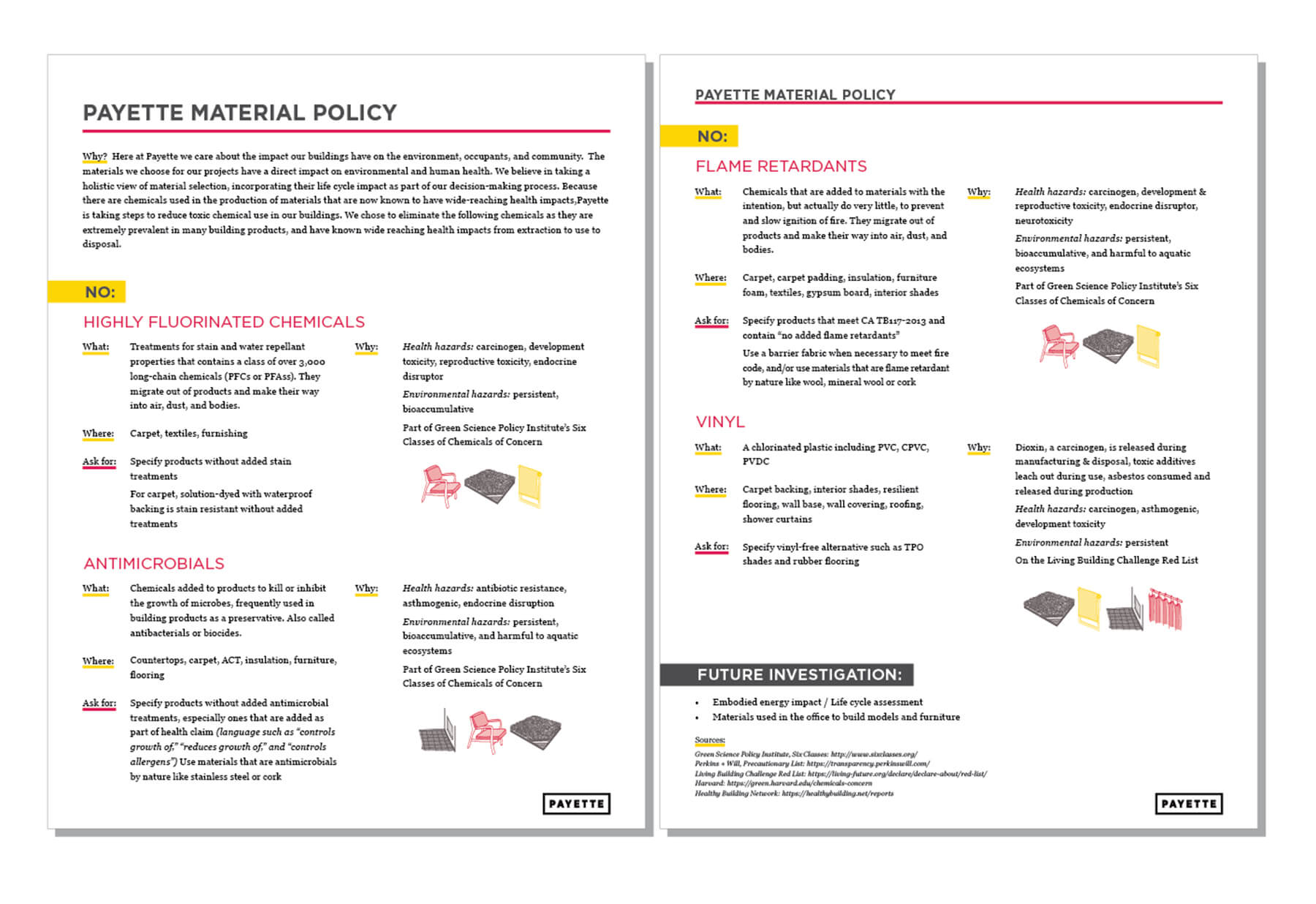In December of 2018, the Material Research Team formally launched PAYETTE’s Material Policy. This follows a year of research on issues of human and environmental health surrounding the material decisions that we make as designers. Read more about what influenced the policy.
Our goal is to have broad impact by addressing classes of chemicals and materials that are found in many of the materials and finishes we select, which will allow for a positive health impact. The policy is meant to be a living document that will evolve as industry knowledge expands, and as the firm develops our design and selection processes.
 We began by reviewing the practices of our peers, industry and institutional resources and sustainable rating systems. Through this process we decided that the first iteration of our policy would focus on eliminating target areas that we repeatedly found to be the worst offenders. These commonly found chemicals and materials have a range of health and environmental hazards including: carcinogenic, development and reproductive toxicity, endocrine disruptor, asthmogenic, neurotoxicity, and they are persistent and bioaccumulative.
We began by reviewing the practices of our peers, industry and institutional resources and sustainable rating systems. Through this process we decided that the first iteration of our policy would focus on eliminating target areas that we repeatedly found to be the worst offenders. These commonly found chemicals and materials have a range of health and environmental hazards including: carcinogenic, development and reproductive toxicity, endocrine disruptor, asthmogenic, neurotoxicity, and they are persistent and bioaccumulative.
Our main target areas are:
Highly Fluorinated Chemicals
- What: Treatments for stain and water repellant properties
- Commonly found in: Carpet, textiles, furnishing
Antimicrobials
- What: Chemicals added to products to kill or inhibit the growth of microbes
- Commonly found in: Countertops, carpet, ACT, insulation, furniture, flooring
Flame Retardants
- What: Chemicals that are added to materials with the intention (but actually do very little[1]) to prevent and slow ignition of fire
- Commonly found in: Carpet, carpet padding, insulation, furniture foam, textiles, gypsum board, interior shades
Vinyl
- What: A chlorinated plastic including PVC, CPVC, PVDC
- Commonly found in: Carpet backing, interior shades, resilient flooring, wall base, wall covering, roofing, shower curtains
 How are we implementing this?
How are we implementing this?
- Developing numerous tools to assist designers to select healthier options
- Educational events in the office
- Optimizing our specifications, which will have an extensive impact across all projects
- Filtering and labeling our internal materials library
Additionally, we are exploring areas for future inclusion in our policy such as Life Cycle impacts and reviewing materials used internally to fabricate models and our office furniture. Through initiating this policy, PAYETTE’s goal is to further integrate this knowledge of health and environmental impacts into our design process.
Footnotes/Additional Sources:
[1] http://media.apps.chicagotribune.com/flames/index.html
The Six Classes: https://www.sixclasses.org/videos
Antimicrobial White Paper:
PVC White Paper: http://assets.ctfassets.net/t0qcl9kymnlu/2zkiia6MZ2O66GuweuQqcI/6b3fd8d87e66439d207f3be73a6be193/PerkinsWill_PVC_2015_Whitepaper_0.pdf
PVC report: https://healthybuilding.net/reports/18-chlorine-building-materials-project



